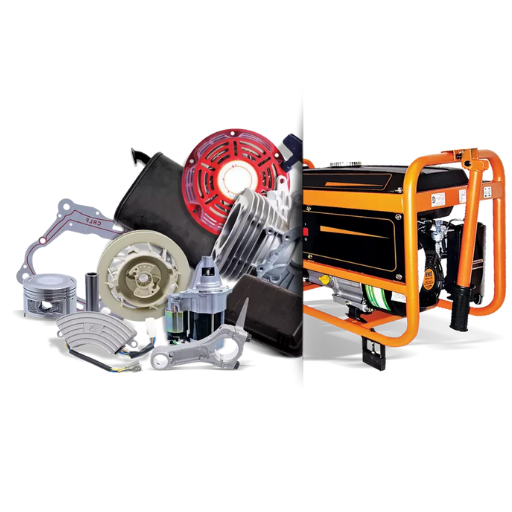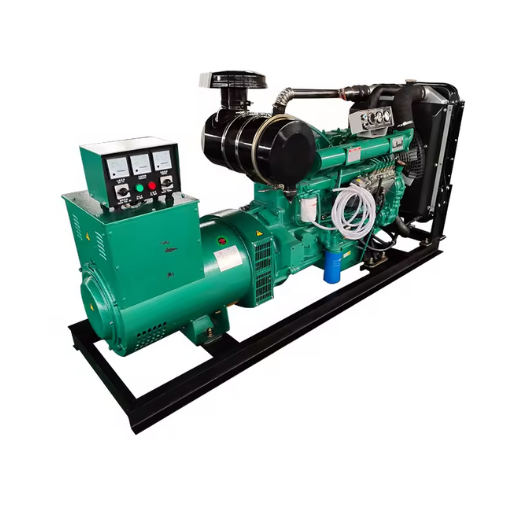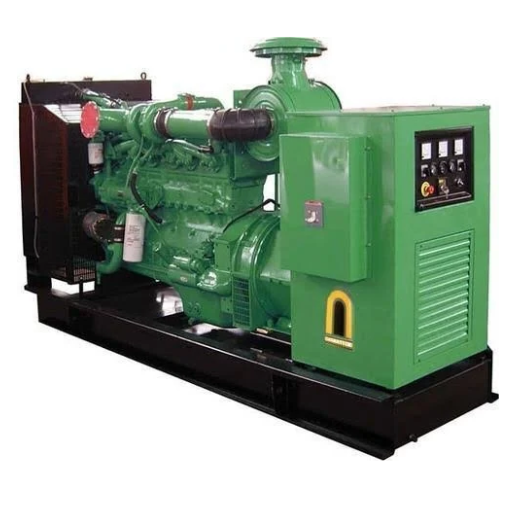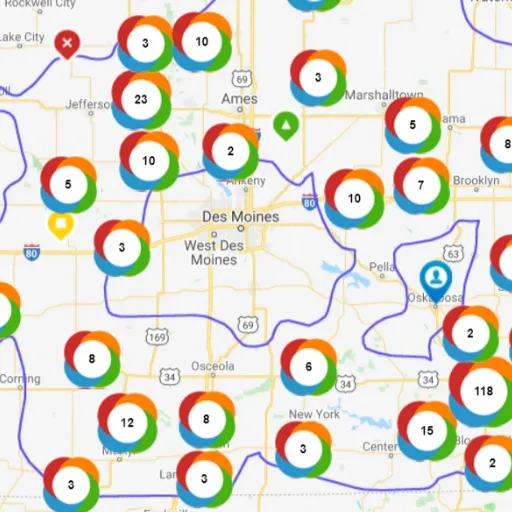Generators are indispensable tools for providing reliable power at a construction site, in emergencies, or in support of off-grid systems. However, optimization of generator performance demands more than mere starting—it needs understanding of its basic components and how they interface. This article will provide you with working knowledge of the basic components of a generator by highlighting their functions and why they are essential to its efficiency and lifespan. Whether you are an efficient technician or an interested user, this guide will empower you with knowledge for maintaining and improving generator efficiency, offering someone dependable power at a time when it is most required.
What Are the Key Generator Parts You Should Know?

A generator encompasses several key parts that work together to produce and supply power to the outside world. The following are the main components of a generator:
- Engine—The engine is the prime mover and the main factor in establishing a generator’s capacity and overall power output. A well-maintained engine will perform well, whereas a poorly maintained one will consume money and perform poorly.
- Alternator – The alternator converts mechanical energy from the engine into electrical energy. It consists of components such as the rotor and stator that generate electricity.
- Fuel System—This system stores fuel and supplies it to the engine. Depending on the generator type, the fuel employed includes gasoline, diesel, or propane.
- Voltage Regulator—A voltage regulator maintains a stable parameter of output electricity and controls the generator’s voltage levels.
- Cooling and Exhaust Systems – These systems prevent the generator from overheating and safely expel exhaust gases produced during operation.
- Lubrication System—Designed to reduce friction and wear, the system lubricates moving machinery so that it may operate smoothly.
- Battery – The battery feeds the starter and initiates the generator.
- Control Panel—The control panel allows the user to control the generator and view information about the system’s status, starting, output voltage, and warnings.
Each of these parts is involved in the essential operations of the generator, ensuring reliable and effective power generation. Regular maintenance of all components is important to keep them operating for a long time.
Understanding the Generator Engine
The generator engine, the heart of a generator, takes fuel and converts it into mechanical energy, which an alternator converts into electrical energy. There are various types of engines with different sizes and fuel requirements, depending on the use and the power required. The following are some components and significant data on the generator engine that concentrate on the efficiency and performance of the generator:
- Types of Fuel Used
Generator engines can work on a diverse range of fuels, such as gasoline, diesel, natural gas, or propane. Diesel engines are more fuel-efficient and longer-lasting, thereby being used in an industrial setting, while gasoline engines are smaller and more appropriate for residential or contractor applications. Natural gas generators are environmentally friendly and best for long-term power needs.
- Engine Size and Capacity
The size of the generator engine varied from small engines of a few kilowatts (kW) to be used in residential applications to large industrial engines that would work in thousands of kilowatts or even megawatts (MW) to power factories, data centers, and the like. For instance:
- Small portable generator: ranges from 1 kW to 10 kW.
- Standby or industrial generators: in the region of 2 MW and beyond
- Efficiency and Fuel Consumption
The engine’s efficiency depends on its load and fuel. For example:
- When working at full load, a 5 kW diesel generator may consume a gallon of fuel in an hour.
- Large capacity engines running on natural gas provide greater continuous power and energy output per unit fuel cost.
- Cooling System
The generator engine must be cooled to prevent it from overheating during operation. It could be air—or liquid-cooled, with liquid cooling preferred for larger industrial units because of its higher efficiency.
- Emission Standards
Modern generator engines are built to comply with stringent emission standards to diminish their impact on the environment. The EPA (Environmental Protection Agency) sets Tier emission standards to regulate engine pollutants, which is very pertinent in the U.S.
- Maintenance and Lifespan
Regular maintenance practices like oil changes, air filter replacements, and spark-plug checks significantly affect engine health and generator performance. Considering the average lifespan of a well-maintained diesel engine is between 10,000 and 30,000 hours, smaller and less robust engines may be shorter.
Key Example Data
- Fuel Efficiency (Diesel Generator, 10 kW): Around 0.4 gallons/kWh.
- Noise Levels (Small Residential Gasoline Engine): Set at about 60-70 dB.
- Running Hours (Standby Generators): Loading for 500 hours yearly.
Going deeper into the generator engine, its defects, and its data allows persons to make a good choice suitable to their requirements and ensures the optimum performance and reliability of the generator.
The Role of the Water Pump in Generators
|
Key Point |
Description |
|---|---|
|
Primary Function |
Ensures consistent water flow for cooling. |
|
Energy Conversion |
Converts fuel to mechanical energy for pumping. |
|
Cooling Role |
Prevents generator overheating. |
|
Applications |
Used in homes, farms, and industries. |
|
Key Components |
Engine, pump, and generator. |
|
Efficiency |
Optimized for fuel and energy savings. |
|
Durability |
Designed for harsh conditions. |
|
Maintenance |
Requires regular checks and cleaning. |
|
Power Requirements |
Depends on the pump size and the generator capacity. |
|
Versatility |
Suitable for irrigation, backup, and draining. |
The Importance of Voltage Regulators
Generator voltage regulators are crucial components since they provide a stabilized output voltage. Fluctuations in the power supply can damage electrical equipment connected to the generator, while unreliable operations can adversely affect the equipment.
How to Choose the Right Generator for Your Needs?

A few key factors must always be considered when selecting a generator:
- Power Requirements: Identify the total wattage that you need. Laying all appliances, tools, or equipment the generator will power. Ensure the generator can meet both running and starting watts.
- Fuel Type: Choose gasoline, diesel, propane, or natural gas generators. Depending on fuel types, there are advantages in availability, cost, or storage.
- Portability: A portable generator is convenient for moving around. On the other hand, a standby generator might be more suitable for a permanent backup power supply at work or home.
- Runtime: How long will the generator run on a full fuel tank? If extended power outages or remote use are significant concerns, the longer the runtime, the better.
- Safety Features: Auto shutdown for low oil, overload protection, etc., make the operation safe.
- Noise Levels: If excessive noise is a consideration in residential or quiet environments, check the decibel levels.
- Budget: A generator that fits what you can afford while balancing good quality is what you should go for.
By analyzing these factors meticulously, you can then buy a generator that meets your requirements and performs well whenever you need it.
Evaluating Portable Generators
|
Key Point |
Description |
|---|---|
|
Power Output |
Ranges from 3,000 to 8,500 watts. |
|
Fuel Type |
Gasoline, propane, or dual-fuel options. |
|
Portability |
Equipped with wheels and handles for mobility. |
|
Noise Level |
Quieter models operate at 50-60 decibels. |
|
Run Time |
Varies based on tank size and load. |
|
Safety Features |
Includes CO shutoff and low-oil shutoff. |
|
Startup Options |
Electric or manual pull-start available. |
|
Weight |
Lightweight models for easier transport. |
|
Cost Range |
Typically $400 to $3,000. |
|
Applications |
Ideal for home backup, camping, and job sites. |
Understanding Generator Transfer Switches
A generator transfer switch is a critical device needed for the proper and safe interconnection of a generator into your home or business electrical system. It provides an alternative source of electricity from the utility grid and generator systems, prohibits backfeeding into the grid, and therefore maintains safety. Below are five common types of generator transfer switches.
- Manual Transfer Switches
These switches need to be manually operated, switching power from the main utility source to a generator and vice versa. These operate without automatic innovation during outages, so they are less expensive and somewhat workable for small applications.
- Automatic Transfer Switches (ATS)
The automatic transfer switch shuts off the supply and turns on the generator without human intervention once it detects a power outage, thus ensuring an uninterrupted power supply for homes and critical places such as hospitals or data centers.
- Switchable Main Breaker Panels
This option is a sort of cross-hybrid between a transfer switch, main breaker panel, and power distribution panel, thus minimizing installation time and cost. Another advantage is saving space and buying less equipment.
- Outdoor Transfer Switches
These are meant to be installed outdoors, so they are weather-proof and will keep the switch protected from environmental hazards. They can be implemented for outdoor generators.
- Service Entrance Rated Transfer Switches
These switches provide a built-in breaker rated for a utility service entrance. They are convenient for both residential and commercial services and offer an all-in-one solution for ease of installation.
Knowing the different types of generator transfer switches available will help you make the right choice for your power needs and operational standpoint.
Finding the Right Parts for Your Generator
Getting the right generator parts always revolves around knowing the model number and specifications for the generator model at my home. Then the manufacturer’s manual is checked, and the serial number is located to ensure compatibility of replacement parts. On top of that, I insist on buying only from legit dealers to guarantee that the parts will be highly reliable and of perfect working quality. This way, my generator is maintained until sorely needed, in excellent working order and all very efficiently.
How to Perform Generator Maintenance?

For smoother generator maintenance, the steps would be:
- Check the Oil Levels – Get into the habit of checking and changing the oil, as recommended by the manufacturers, for smooth operation.
- Clean or Change the Air Filter—Keeping the air filter clean allows smooth airflow, which helps with performance.
- Inspect the Spark Plug—Open it and inspect for any trace of wear or residue. If so, change it.
- Test the Battery- Check the battery charge; clean off any terminal corrosion.
- Run It – Weekly periodic running of the generator shall keep it workable and may identify issues.
- Check the Fuel Levels and Filters – Consistently use fresh fuel and verify the status of the fuel filter, cleaning, or changing it as required.
Always adhere to the manufacturer’s instructions for the maintenance schedule and procedure.
Utilizing Maintenance Kits for Upkeep
Maintenance kits are critical for the reliable operation and longevity of the generator. They would generally contain spark plugs, oil filters, air filters, and fuel stabilizers- the ultimate components for increased maintenance. Recent research posits that placing a maintenance kit with the generator may extend the operational life by 30%. Maintenance kits for generators are usually designed for specific generator models, which makes it easier to find parts to be serviced.
For instance, fuel stabilizers in the current maintenance kits are advanced and specifically kept to prevent fuel degradation during prolonged storage periods so that the generator starts well when called into service. The spark plugs populating these kits work fine because the better the spark plugs, the better the combustion of the fuel, thus reducing emissions by up to 10 percent, which is fairly significant.
A simple online search would suggest that any major maintenance kit, at the least, would save up to $250 in repairs annually by averting critical part failures. Try and follow the included step-by-step instructions for the kit; also, try to stay with the maintenance schedule in your manual to make the most out of your investment.
Scheduling Regular Generator Engine Checks
It remains critical to regularly check generator engines to ensure good performance and the length of equipment life. I always consider the manufacturer’s recommended time intervals for checking, inspect, and servicing all the components. Therefore, I can identify faults early, avoid unexpected breakdowns, and ensure the generator runs efficiently during moments when I need it most.
Addressing Common Generator Parts Issues
|
Issue |
Description |
Solution |
|---|---|---|
|
Battery Failure |
Dead or corroded battery. |
Clean terminals or replace the battery. |
|
Engine Won’t Start |
Caused by low fuel, oil, or spark plug issues. |
Check fuel, oil, and replace spark plugs. |
|
Low Coolant |
Leads to overheating. |
Refill coolant and inspect for leaks. |
|
Fuel Line Clogs |
Caused by oxidation or debris. |
Clean or replace fuel lines. |
|
Oil Leaks |
Often due to wet stacking or worn seals. |
Replace seals and clean exhaust system. |
|
Control Panel Issues |
Malfunctioning or incorrect settings. |
Reset or repair control panel. |
|
Clogged Filters |
Dirty air or oil filters. |
Clean or replace filters regularly. |
|
Dead Circuit Board |
Damaged by power surges or pests. |
Replace the circuit board with professional help. |
|
Fuel Gauge Malfunction |
Incorrect fuel level readings. |
Manually check fuel and repair the gauge. |
|
Block Heater Failure |
Worn due to constant use. |
Replace the block heater as needed. |
Where to Find Replacement Parts for Your Generator?

|
Source |
Description |
Website |
|---|---|---|
|
Generator Factory Outlet |
Offers parts for DuroMax, Generac, and more. |
generatorfactoryoutlet.com |
|
AP Electric |
Specializes in Generac, Kohler, and Cummins parts. |
apelectric.com |
|
Home Depot |
Sells generator parts with in-store pickup. |
homedepot.com |
|
eReplacementParts |
Provides OEM parts with repair guides. |
ereplacementparts.com |
|
America’s Generators |
Supplies industrial generator parts. |
americasgenerators.com |
Using Parts Lookup Tools
Parts lookup tools, in combination with timely information from modern search engines such as Google, make it effortless to identify, locate, and purchase the specific replacement parts needed for your generator.
Exploring OEM Options
Regarding replacement parts for your generator, OEM parts are assured to be of high quality, compatible, and reliable. Hence, OEM parts with design specifications specifically for your generator model reduce concerns linked to inferior or incompatible parts. That OEM distributors include detailed compatibility charts, installation instructions, and warranty guarantees as part of their OEM parts package, making them an excellent choice for maintenance or repair.
Locating OEM parts for your generator could be done through the manufacturer’s website or any certified distributor. They provide websites with easy-to-navigate parts lookup tools to find and order the exact part you need, such as Cummins, Generac, and Kohler. For example, a Google search for “Generac generator fuel pump OEM” would yield precise listings from both the official brand site and authorized resellers. Some documentation is usually included with OEM parts to help with proper installation, whereas generic parts lack such documentation and support, which may eventually affect their performance.
Consulting with an Authorized Dealer
By consulting and obtaining any of my generators through an authorized dealer, I know I shall be given expert advice for my generator’s particular make and model, detailed directions, genuine OEM parts for replacement, and exact specifications to solve my problem. This way, I am pretty sure that the generator gaze I keep will stay dependable with continued performance.
How Does a Generator Transfer Switch Work?

Whenever an outage occurs, a generator transfer switch safely transfers the electrical load from the main power source to the generator. During an outage, the switch first disconnects your home or building from the utility grid to prevent backfeeding, which presents a serious hazard to utility workers. Then the switch connects the generator to your electrical system to supply power to the selected circuits. Once utility power is restored, the transfer switch reconnects to the grid and shuts off the generator. It is this transfer of power that should be smooth yet safe.
The Basics of Automatic Transfer Switches
| Key Point | Description |
|---|---|
|
Primary Function |
Switches power between primary and backup sources. |
|
Operation |
Automatically detects outages and activates backup. |
|
Transition Types |
Open, closed, and delayed transitions are available. |
|
Power Sources |
Supports utility, generator, and solar systems. |
|
Applications |
Used in homes, hospitals, and data centers. |
|
Safety Features |
Protects against surges and voltage fluctuations. |
|
Manual Mode |
Can be operated manually for testing or backup. |
|
Types |
Includes 1-phase, 3-phase, and smart ATS. |
|
Installation |
Requires professional setup for safety compliance. |
|
Maintenance |
Regular checks ensure optimal performance. |
Installation and Reliability Considerations
Key factors to consider to have the automatic transfer switches installed and maintained for maximum performance and long-term reliability are given below:
- Proper Sizing and Load Assessment
Ensure the transfer switch is appropriately sized for the generator and electrical load. Undersized switches would lead to system failures, while over-sizing them would be a waste of resources and an additional cost.
- Compliance With Local Codes and Standards
Check that the installation complies with the area’s relevant electrical codes and regulations. This guarantees safety and prevents legal or operational problems.
- Professional Installation
Have certified electricians or professionals perform the installation. Incorrect wiring or improper configuration can cause problems and hazards.
- Regular Maintenance
Arrange for periodic inspection and maintenance of the transfer switch. Consider ultimate wear, secure connections, and functionality tests so as not to lose any chance of working in an unexpected outage.
- Environmental Conditions
Consider the conditions under which the switch will be installed, such as temperature, humidity, and exposure to dust and debris. The switch should be housed or enclosed to ensure maximum protection from its environment. Such considerations will help prolong switch life and maintain performance.
Ensuring Peak Performance During Power Outage
For peak performance during power failures, one must abide by the best practices and ensure that strong systems are in place to provide reliability and efficiency. Some of the considerations borne out by recent findings are as follows:
- Regular Testing and Maintenance
Carry out regular checks to ascertain the working condition of your transfer switch and generator. Industry experts have reiterated that potential problems can be detected early through load bank testing at least once a year, which also assures that your backup power system is able to handle the required load. Neglecting to perform such tests can affect your system’s ability to stand and perform adequately during an outage.
- Invest in Automatic Transfer Switches (ATS)
This is considered a contemporary approach to curtailing downtime caused by a power interruption. Reports in the industry indicate that ATS works in milliseconds to switch power over to a secondary source, ensuring continuity of operations for critical facilities such as hospitals, data centers, and manufacturing plants.
- Monitoring and Data Analysis
Employ smart monitoring solutions to observe generator and transfer switch performance in real time. Gartner also suggests that maintenance systems integrated with IoT sensors can boost operations efficiency by 25 percent, mostly through predictive maintenance and early fault detection.
- Fuel Management
Maintain a stock of good-quality fuel for your backup generators. Studies show fuel degradation within 6 to 12 months, especially for diesel, which may lead to clogging of important components. Fuel polishing and storage best practices should be followed to circumvent this threat.
- Environmental Preparedness
If the system is outdoors, opt for weatherproof enclosures to shield it from harsh environmental conditions. Studies elucidate that installations without proper protection from temperature fluctuations and excessive moisture are 35 percent more prone to failure over time.
The business world and homeowners can guarantee power systems by adopting such strategies and using advanced technology.
References
-
Generator Group Project – This paper explores generator tube integrity and inspection issues, offering technical details on generator components.
-
Understanding, Designing and Building a Hydroelectric Generator – This project provides a detailed study on combining hydro and electrical parts in generator design.
Frequently Asked Questions (FAQ)
Q: What are the essential generator parts needed for optimal performance?
A: Essential generator parts include the stator, rotor, circuit panel, seals, and plugs. These components are crucial for ensuring the generator’s reliability and efficiency. Regular maintenance and replacement of these parts can keep your generator running smoothly.
Q: How does a Generac generator differ from other brands?
A: Generac generators are known for their high-quality performance and reliability. They offer a wide range of generator systems, including standby and backup generators designed to meet various power generation needs. Generac is a trusted manufacturer in the industry.
Q: Why is it essential to use high-quality generator replacement parts?
A: Using high-quality generator replacement parts ensures the durability and longevity of your generator. It helps maintain the generator’s performance and reliability, reducing the need for frequent repairs and extending its overall lifespan.
Q: What should I consider when selecting a new generator for my home?
A: When selecting a new generator, consider its power source, capacity, and compatibility with your current electrical system. It’s also essential to check for features like air-cooled systems and the availability of reliable generator parts and accessories for maintenance.
Q: How do I ensure my generator is ready during an emergency?
A: To ensure your generator is ready for emergencies, perform regular maintenance checks, replace worn-out parts, and test the generator periodically. Keeping a stock of essential components can help keep your generator running in critical times.
Q: What are the benefits of free shipping on generator parts?
A: Free shipping on generator parts and accessories makes obtaining the components you need easier and more cost-effective. It ensures that you can quickly replace or repair parts without additional shipping costs, helping to maintain your generator’s optimal performance.
Q: How can I improve the performance and reliability of my industrial generator?
A: To improve the performance and reliability of an industrial generator, ensure regular maintenance, use high-quality parts, and follow the manufacturer’s guidelines. Regularly inspect electrical and mechanical components to prevent unexpected failures.
Q: What role does the stator play in a generator?
A: The stator is a crucial component in a generator that helps convert mechanical energy into electrical energy by creating a current. A properly functioning stator is essential for efficient power generation and to ensure the generator operates smoothly.
Q: Why do generators require regular maintenance?
A: Generators require regular maintenance to prevent breakdowns, ensure safety, and maintain optimal performance. Regular checks help identify potential issues early, allowing for timely repairs and replacements and ensuring the generator’s reliability.
Q: What is the importance of seals in a generator?
A: Seals in a generator are vital for preventing leaks and protecting internal components from contamination. They help maintain the generator’s efficiency and reliability by ensuring the mechanical parts operate correctly and without obstruction.







